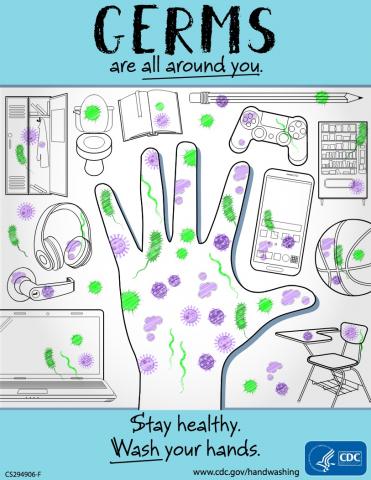Experts tell us that washing our hands, for twenty seconds, is the most-effective way to protect ourselves against novel Coronavirus. So here’s a question to ponder: What makes a simple bar of soap a lethal weapon against the virus SARS-CoV-2 which causes the disease COVID-19?
The short answer is: Before sending this virus down the drain, soap first annihilates it. Completely destroys it. Rips the nasty virus to pieces. But ... we have to give it enough time—20 seconds—to do its job while we properly wash our hands.
Really? Soap, which has been around since ancient times, is deadly to a deadly virus? How can that be?
To understand how soap kills SARS-CoV-2, we have to apply some scientific (and a bit of Greek) thinking. There’s something special about soap. Its molecules are known as “amphiphiles.” That word—“amphiphiles”—is based on two Greek words: “amphis” (which means “both”) and “philia” (which is a type of “love”).
A soap molecule has two ends with two very different characteristics. The polar end is water-loving (hydrophilic) and fat-resistant; the nonpolar end is fat-loving (lipophilic) and water-resistant. This compound molecular structure allows amphiphiles to do amazing things.
One end of an amphiphile is attracted to water but is repelled by proteins and fats. The other end is attracted to fats and proteins but is repelled by water. Professor Pall Thordarson, who has an interest in nanomedicine, helps us to understand what this means in real life. He’s a professor of chemistry at the University of New South Wales (in Australia).
What happens if we pour fat-containing olive oil into water? The oil pools together—then it floats. The fat-containing substance pools and floats because, as Dr. Thordarson reminds us: “Fats don’t mix with water.”
Now let’s add some soap to our oil-and-water experiment. What happens? First, the soap molecules form a ring around the oil. That ring is called a micelle.

Then the olive oil will start to disperse. Why?
Soap is attracted to the oil, because of its nonpolar fat-loving side, but then it starts to tear it up and pull it into the water with its polar water-loving side. We could think of it like a one-two battle punch: First surround the enemy, then move them away from each other.
Let's watch how this works with a video from MIT:
These contrasting natures, within a single bar of soap, make this humble and inexpensive cleaner-of-hands very effective. Professor Thordarson says: “When you buy a conventional soap, it consists of a mixture of these amphiphiles.”

We’re now ready to apply this knowledge to the world of a new coronavirus which began to threaten the world’s population in late 2019.
We can compare the coronavirus SARS-CoV-2 to the olive oil in our experiment. The virus has bits of genetic information, encoded by RNA, encased in a coating of fat and protein. To help us understand the nature of this tiny virus, Dr. Thordarson refers to it as “nano-sized grease balls.”
Have you ever attacked a grease ball with soap? The soap destroys the grease ball. The same thing happens when soap meets a COVID-19-causing virus. When soap enters the virus' lipid bilayer envelope, it acts “almost like a crowbar; it starts to pull all the things apart,” explains Professor Thordarson.

The fat-loving side of a soap molecule attacks the virus by burrowing into its fat-and-protein shell. Because the chemical bonds which hold this particular virus together are fairly weak, the molecular invasion is sufficient to break the virus’ coating. Once the virus’ coating is broken, the virus gets pulled apart. When the virus is pulled apart, it becomes water-soluble. A water-soluble virus is a disintegrating virus.

That’s how soap can destroy the SARS-CoV-2 virus. But ... it takes time - about 20 seconds - for this process to work.
Why so much time? Have a look at your finger tips. Do you see those tiny folds and wrinkles? Our finger tips aren’t smooth, and those folds and wrinkles are good hiding places for the virus.
To make sure that soap has had enough time to do its job, interacting with and destroying the virus particles, we have to do more than apply a quick rinse with a tiny bit of soap. By the time we’re finished with a 20-second hand wash, the virus has been transformed into harmless shards of its former self, heading to the drain.
Never fail to remember that our hands are also attraction points for other types of viruses and bacteria. Even if soap cannot kill every single type of invisible bug lurking within those folds on our fingertips—like soap can kill the COVID-19-causing virus—proper hand-washing will at least keep those other viruses and bacteria away from our faces.
People, consciously or unconsciously, touch some part of their face with their hands around 23 times an hour. That’s how viruses—like the novel coronavirus SARS-CoV-2—enter our bodies (where they can cause an awful disease). That's why it is so important to keep our hands clean.
What about hand sanitizers? Do they work as well as soap-and-water? Dr. Thordarson answers that question, too.
In addition to social distancing, every respected national health-care expert tells us to frequently wash our hands with soap-and-water for at least 20 seconds, each time, as a first-line defense against contracting COVID-19. Now you know why.




